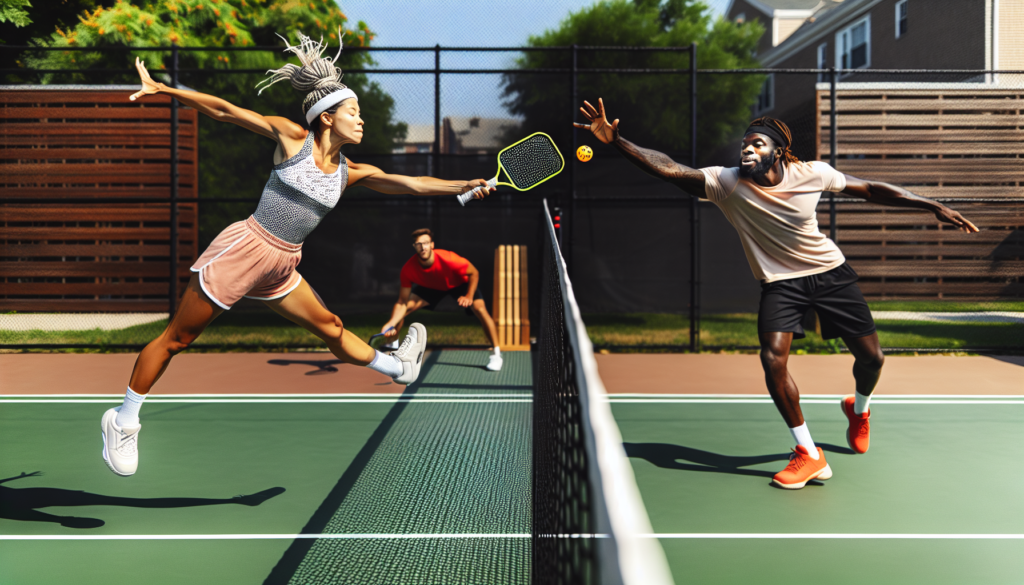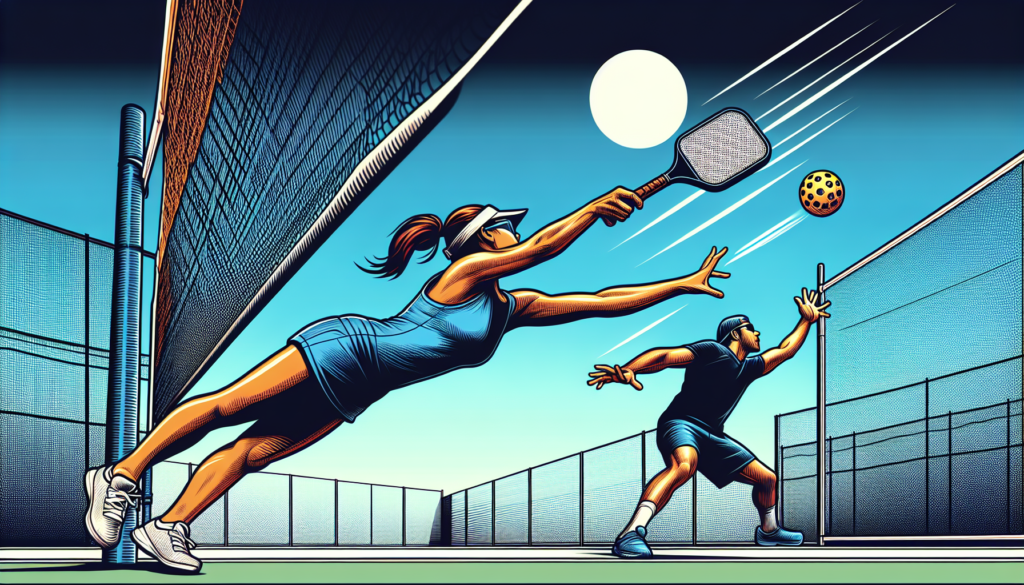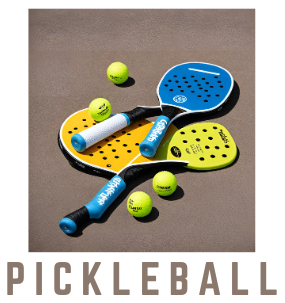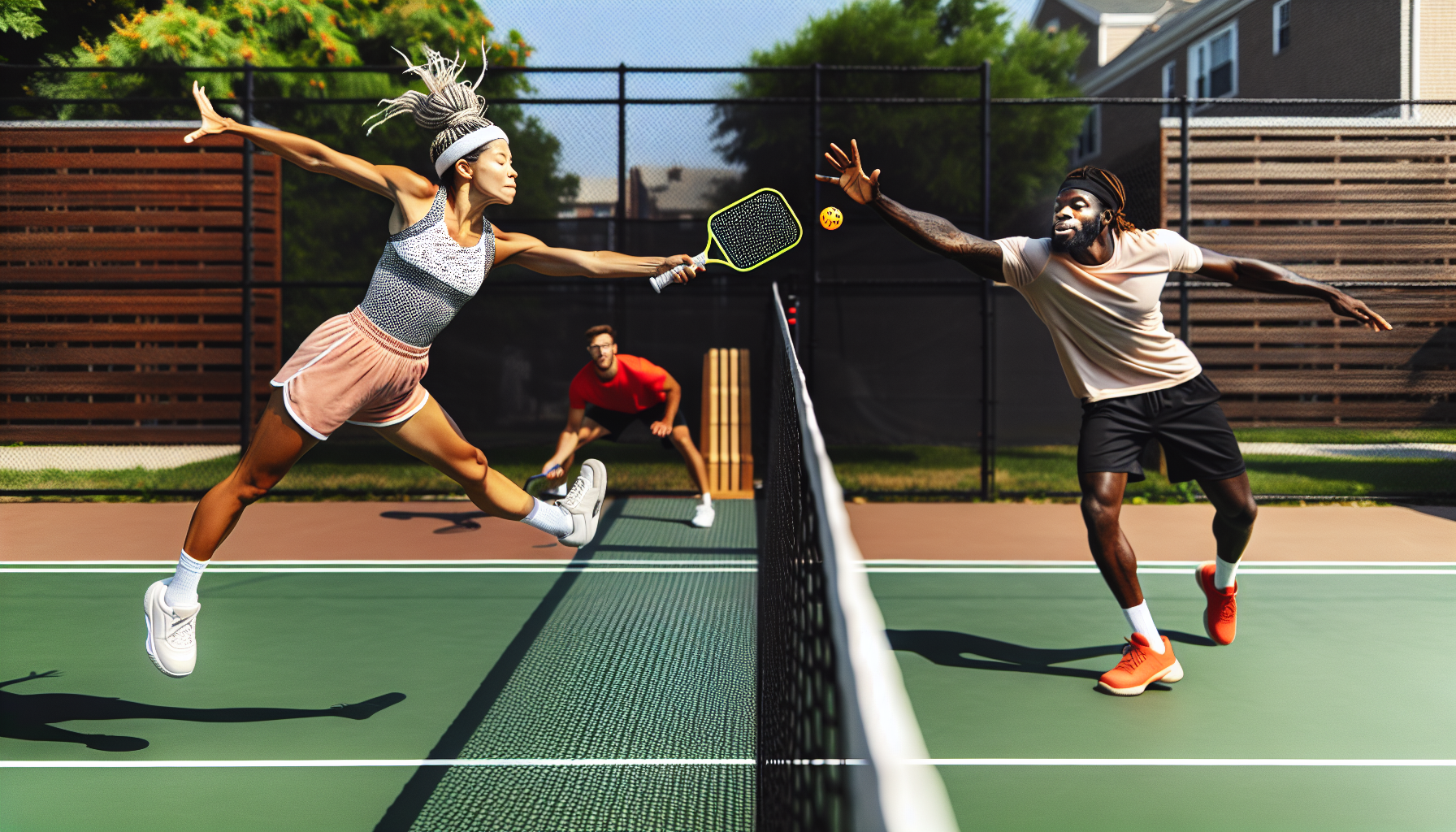Are you new to the game of pickleball or looking to improve your skills? In this article, we will explore 10 Pickleball mistakes that players make and how to avoid them. From improper grip techniques to not positioning yourself correctly on the court, these tips will help you avoid some of the most common pitfalls and elevate your game to the next level.
Whether you’re a beginner or an experienced player, learning from these mistakes will undoubtedly enhance your pickleball performance. So let’s jump right in and discover how to steer clear of these 10 pickleball blunders!
1. Impractical Serve Strategy
Lack of Consistency in Serve Placement
One common mistake that many pickleball players make is a lack of consistency in their serve placement. When serving, it’s crucial to have a specific target in mind and consistently aim for that spot. By doing so, you can put pressure on your opponents and make it harder for them to return your serve effectively. However, if you randomly aim for different spots on the court with each serve, you’ll find it challenging to build momentum and keep your opponents on their toes.
Failure to Utilize Spin
Spin is a powerful tool in pickleball, as it can disrupt your opponent’s timing and create opportunities for you to gain an advantage. Unfortunately, many players fail to utilize spin effectively in their serves. Whether it’s a topspin serve to keep the ball low and force your opponent into a difficult return or a slice serve to make the ball curve away from them, adding spin to your serves can dramatically improve your chances of success. Neglecting to use spin is a missed opportunity to throw off your opponents’ rhythm and make your serves more challenging to handle.
Overreliance on Power Serves
While a powerful serve can be intimidating, relying too heavily on power serves can be a mistake. Hitting the ball as hard as possible may give you a few aces, but it also increases the risk of missing your serve or sending it out of bounds. Additionally, power serves are generally easier for experienced players to return, as they have more time to react to the fast-paced ball. Instead of solely relying on power, consider mixing up your serves with different speeds and placements to keep your opponents off balance.
2. Poor Positioning on the Court
Failure to Cover the Dink Shot
The dink shot is a soft, finesse shot that is essential in pickleball. It involves gently tapping the ball over the net, close to the net, and aiming for a drop just outside your opponent’s reach. However, many players fail to cover the dink shot effectively, leaving themselves vulnerable to a well-placed dink from their opponent. By being proactive and anticipating the dink shot, you can position yourself strategically and be ready to react quickly.
Inadequate Movement Between Shots
Moving efficiently and quickly between shots is crucial in pickleball, but some players struggle with adequate movement on the court. Whether it’s failing to get back into position after hitting a shot or not being able to reach shots due to slow footwork, inadequate movement can severely limit your ability to play effectively. To improve your movement, focus on maintaining an athletic stance, always being on your toes, and being ready to respond to your opponent’s shots.
Lack of Awareness of Opponent’s Court Position
Understanding your opponent’s court position is essential for strategic decision-making during a pickleball match. However, many players fail to pay enough attention to their opponent’s movements and end up making poor shot choices as a result. By being aware of where your opponent is on the court, you can aim for open spaces, exploit their weaknesses, and put them in uncomfortable positions. Ignoring your opponent’s court position is a missed opportunity to gain an upper hand and dictate the flow of the game.
3. Lack of Net Game Skills
Inability to Execute a Proper Volley
Volleying is a fundamental skill in pickleball that can help you maintain control and put pressure on your opponents. However, many players struggle with executing proper volleys. Whether it’s mistiming the contact with the ball, using the incorrect grip, or not being able to redirect the ball effectively, a lack of volleying skills can hinder your ability to maintain dominance at the net. Practice your volleys consistently, focus on your hand-eye coordination, and work on finding the right balance between power and control.
Failure to Follow Up on Volleys
Following up on a well-executed volley is just as crucial as the initial shot itself. Unfortunately, some players fail to capitalize on their successful volleys and instead retreat back to a defensive position on the court. By not actively pursuing the next shot after a volley, you give your opponents an opportunity to regain control and potentially turn the tide of the rally. After a successful volley, be aggressive, maintain your position at the net, and be ready to intercept any returns or weak shots.
Weak or Ineffective Drop Shots
Drop shots can be a strategic weapon that forces your opponents to move quickly and creates opportunities for you to gain the upper hand. However, many players struggle with executing effective drop shots. Whether it’s hitting the ball too hard and allowing your opponents to easily retrieve it or not placing the ball close enough to the net, weak or ineffective drop shots can be detrimental to your game. Practice your drop shots, focus on finesse and touch, and work on perfecting the art of dropping the ball just over the net and near the kitchen line.
4. Incorrect Shot Selection
Poor Choice of Shots During Rallies
Making the right shot choices during rallies is crucial for maintaining control and putting pressure on your opponents. However, some players consistently make poor shot choices that leave them vulnerable and allow their opponents to take control of the rally. Whether it’s attempting a difficult passing shot instead of a safer dink, going for winners from unfavorable positions, or neglecting high-percentage shots, poor shot selection can be a costly mistake. Take the time to assess the situation, consider your options, and choose the shot that gives you the best chance of success.
Inability to Adjust Shot Velocity or Angle
Pickleball is a dynamic sport that requires adaptability and the ability to adjust your shots on the fly. Unfortunately, some players struggle with adjusting the velocity or angle of their shots based on the situation at hand. Whether it’s hitting every shot with the same amount of power or failing to add variation to your shots during a rally, this lack of adaptability makes it easier for your opponent to anticipate your shots and formulate effective counters. Practice varying the speed and angle of your shots, and make a conscious effort to read the game and adjust accordingly.
Neglecting the Lob Shot
The lob shot is a valuable tool in pickleball that can be used to catch your opponents off guard and force them to retreat from the net. However, many players neglect to incorporate the lob shot into their game, missing out on a strategic advantage. By utilizing the lob shot, you can disrupt your opponent’s rhythm, create opportunities for offensive shots, and defend against aggressive net players. Don’t overlook the lob shot as a weapon in your arsenal – practice its execution and add it to your repertoire to keep your opponents guessing.
5. Lack of Communication with Partner
Insufficient Nonverbal Communication
Clear and effective communication with your partner is essential for successful doubles play in pickleball. However, many players struggle with insufficient nonverbal communication, leading to confusion, missed opportunities, and defensive vulnerabilities. Through nonverbal signals, such as eye contact, hand gestures, or positioning, you and your partner can convey your intentions, coordinate strategies, and react quickly to changing game situations. Prioritize practicing and refining your nonverbal communication skills to improve your partnership on the court.
Failure to Establish a Strategy or Signals
Having a well-defined strategy and clear signals with your partner is crucial for cohesive teamwork in pickleball doubles. Yet, many players fail to establish a strategy or develop signals with their partner, resulting in miscommunication and disjointed play. By discussing and agreeing upon a game plan, understanding each other’s strengths and weaknesses, and establishing signals for specific situations, you can maximize your efficiency as a team and make better tactical decisions during matches.
Lack of Trust and Coordination
Trust and coordination are the foundation of a successful partnership in pickleball doubles. Unfortunately, some players struggle with trusting their partner’s abilities and fail to coordinate effectively on the court. Doubt and hesitation can lead to missed opportunities, defensive breakdowns, and a lack of synergy as a team. To overcome these challenges, invest time in developing trust with your partner, practicing together, and fostering open communication. When you have trust and coordination, you can move effectively as a unit, cover each other’s weaknesses, and capitalize on each other’s strengths.
6. Inadequate Footwork
Incorrect Weight Distribution During Shots
Proper weight distribution is crucial for maintaining balance and executing effective shots in pickleball. However, some players struggle with incorrect weight distribution, which can lead to compromised stability and subpar shot execution. Whether it’s leaning too far forward or backward during shots, failing to transfer weight efficiently, or not positioning yourself properly on the court, inadequate footwork can significantly hinder your performance. Practice maintaining a centered stance and focus on shifting your weight correctly to optimize your balance and improve shot accuracy.
Failure to Move Laterally Efficiently
Lateral movement is essential in pickleball, as it allows you to cover the court effectively and reach shots that would otherwise be out of your reach. Unfortunately, some players struggle with moving laterally efficiently, resulting in missed opportunities and defensive vulnerabilities. Whether it’s slow lateral footwork, inefficient steps, or not anticipating your opponent’s shots properly, the inability to move laterally effectively can limit your court coverage and make it easier for your opponents to exploit the open spaces. Practice lateral movement drills, work on quick and agile footwork, and focus on staying light on your feet.
Inability to Maintain Proper Balance
Maintaining proper balance is fundamental in any sport, and pickleball is no exception. However, many players struggle with maintaining balance during shots and movements on the court. Whether it’s lunging too far forward, overextending on shots, or not recovering to a balanced position after hitting the ball, poor balance can negatively impact your shot quality, stability, and overall performance. Focus on maintaining a strong core, practice balance drills, and be mindful of your body position at all times to improve your overall stability and shot execution.
7. Weak Return of Serve
Inconsistent or Weak Groundstrokes
Returning the serve effectively is crucial in pickleball, but some players struggle with inconsistent or weak groundstrokes. Whether it’s mishitting the ball, not generating enough power, or lacking accuracy, a weak return of serve puts you on the defensive right from the start and allows your opponents to dictate the rally. To improve your return of serve, focus on your grip, practice your groundstrokes consistently, and work on generating power and accuracy in your returns.
Failure to Read the Opponent’s Serve
Reading your opponent’s serve is a skill that can greatly enhance your ability to return effectively. However, many players fail to accurately read the opponent’s serve trajectory, speed, and spin, leaving them ill-prepared to execute a well-placed return. By paying attention to your opponent’s body position, racket angle, and ball toss, you can gather valuable information that helps you anticipate the serve and position yourself optimally for a strong return. Stay focused and observant during the opponent’s serve to improve your ability to read and react effectively.
Lack of Variation in Return Placement
A predictable return of serve makes it easier for your opponents to anticipate your shots and take control of the rally. Unfortunately, some players lack variation in their return placement, consistently hitting the ball to the same area of the court. By varying the placement of your returns, you can keep your opponents guessing and create opportunities for offensive shots or strategic positioning. Experiment with different return angles, depths, and speeds to keep your opponents off balance and maximize your chances of success.
8. Overcommitting on Shots
Difficulty in Letting Go of Unreachable Balls
One of the challenges in pickleball is determining when to let go and give up on a shot that is out of your reach. Some players struggle with overcommitting and attempting to hit balls that are clearly unplayable, often resulting in errors or losing points. To overcome this tendency, it’s essential to develop the discipline to recognize when a ball is out of your reach and focus on quickly regaining position for the next shot instead of scrambling to reach a lost cause.
Lack of Patience in Building Rallies
Pickleball is a game that requires patience and the ability to construct rallies strategically. Rushing to end points quickly often leads to forced shots, unforced errors, and missed opportunities to create advantageous situations. Instead, focus on building rallies, patiently waiting for the right opportunity to attack, and forcing your opponents into errors. By exercising patience in your shot selection and rally construction, you increase your chances of success and reduce the likelihood of making costly mistakes.
Tendency to Rush and Force Shots
Rushing and forcing shots is a common mistake among pickleball players, particularly when faced with defensive or challenging situations. Instead of taking the time to set up a proper shot and evaluate the optimal strategy for the rally, some players succumb to the pressure and attempt low-percentage shots that are likely to lead to errors. To overcome this tendency, practice maintaining composure during intense moments, focus on shot quality over quantity, and be willing to reset the rally if necessary to regain control and set up a better opportunity.

9. Lack of Defensive Skills
Inadequate Blocking or Defending Against Smashes
Defending against powerful smashes can be daunting, but it’s an essential defensive skill that every pickleball player should develop. Many players struggle with inadequate blocking or defending against smashes, resulting in lost points and defensive vulnerabilities.
To improve your defense against smashes, focus on positioning yourself close to the kitchen line, keep your paddle in a ready position, and work on developing quick reflexes to return or block powerful shots effectively.
Poor Anticipation of Opponent’s Shots
Anticipating your opponent’s shots is crucial for effective defense in pickleball. Unfortunately, some players struggle with poor anticipation, which leads to late reactions, compromised positioning, and missed opportunities to defend effectively.
To improve your anticipation skills, study your opponent’s patterns, observe their body language and racket preparation, and practice reading their shot cues. By developing your ability to anticipate your opponent’s shots, you can position yourself optimally and respond more quickly and effectively to their attacks.
Failure to Position for Defensive Shots
Proper positioning is essential for defensive shots in pickleball. However, some players fail to position themselves correctly when on the defensive, resulting in defensive vulnerabilities and giving their opponents easy scoring opportunities.
To improve your defensive positioning, prioritize getting into a ready position near the kitchen line, staying balanced and ready to move, and anticipating where the ball is likely to come based on your opponent’s shot selection. With proper positioning, you can react swiftly to defensive shots and maintain control of the rally.
10. Failure to Adapt to Different Opponents
Lack of Adjustments to Opponent’s Playing Style
Each opponent brings a unique playing style to the pickleball court, and failing to adapt to these varying styles can be a significant disadvantage. Some players struggle with making the necessary adjustments to counter their opponent’s strengths and exploit their weaknesses.
It’s crucial to observe your opponent’s playing style, identify their strengths and weaknesses, and adjust your game plan accordingly. By adapting your approach, you can neutralize their advantages and maximize your chances of success.
Ineffective Strategies Against Strong Net Players
Facing strong net players can be challenging, as they excel at aggressive play and dominating the kitchen. However, some players fail to develop effective strategies against such opponents, resulting in a struggle to gain control of the point.
To improve your performance against strong net players, focus on developing strategies that mix offensive and defensive shots, utilize lobs and dinks strategically, and aim to keep the ball away from their preferred volleying areas. Furthermore, practice your net game skills to increase your ability to compete against formidable net players.
Difficulty in Handling Quick and Agile Opponents
Pickleball is a fast-paced sport, and quick and agile opponents can pose a significant challenge. Some players struggle to handle opponents who possess superior speed and agility, leading to defensive vulnerabilities and difficulty in maintaining control of the point.
To improve your performance against quick and agile opponents, focus on improving your footwork, quickening your reaction time, and developing strategies that exploit their movement patterns. By adapting your game to the speed and agility of your opponents, you can level the playing field and compete more effectively.
In conclusion, and taking into account our 10 Pickleball mistakes above, the game of pickleball offers a rich tapestry of strategies, skills, and techniques to master. By addressing and improving upon these ten common mistakes, you can elevate your level of play and enjoy the game to its fullest potential.
Remember to consistently practice the fundamental skills, prioritize communication and teamwork with your partner, and remain adaptable in your approach to different opponents. By doing so, you’ll be well on your way to becoming a more skilled, well-rounded, and successful pickleball player.

If this article ’10 Pickleball Mistakes’ resonated with you, take a look at ‘10 Pickleball Tips‘.

